Tags
Cresta, Elna, Machines, New Home, sewing machine, Singer, Singer Featherweight, Vesta
I have always loved sewing and have always owned at least one machine since the age of 16, but during this last year, since I retired I seem to have acquired a few more!
Singer 28k – (Vicki)
My sewing started on an 1895 Singer 28k at the age of 8, and I have recently restored it and it stitches perfectly. I use it a lot in my new hobby of patchwork and quilting to do a lot of patchwork piecing as it gives me a lot of control and hence accuracy.
The machine is a straight stitch only machine but I now have attachments which mean I can do a zig-zag and make (beautiful) buttonholes amongst other things.
She is named Vicki because she has Victorian decals and was made during Queen Victoria’s reign
Cresta T132-3
Next came a machine bought especially for me in 1969 at the age of 16 to complete my A level Domestic Subjects (Needlework) course.
This machine is a Cresta T132-3 distributed by Cresta from Wolverhampton via sales reps that came to people’s homes and demonstrated them. I have recently learned that these were made by Lada in Czechoslovakia and are sometimes badged as Lada or other names.
The machine is a zig-zag machine and has 3 needle positions. It has cams which are inserted in the top to produce embroidery patterns and a free arm for sewing difficult seams such as sleeve heads. It was the only machine I used from 1972 (when I left home) until 1992. I think it is very much like some of the Elna cam machines from around the same era.
ELNA Diva – (Elsa)
In 1992 I decided I wanted a modern machine and after much research ended up with an ELNA Diva. This was the top of the range machine at the time and was an enhancement of the ELNA 9000. Mainly a change to the colour from dark to white, as the dark machines were not selling well, but also with an improved hook which can be retro fitted to the earlier machines (7000, 8000 and 9000).
It is the last made Swiss Elna model, and since then Elna has been taken over by various companies, now ending up being owned by Janome.
It is a computerised machine, with freearm, which has over 300 stitches including some heirloom stitches and 5 needle positions. I am using it to learn this technique and hope to create an heirloom quilt using some of the stitches. Heirloom sewing is a technique to recreate French hand sewing by machine and is often used on christening gowns and wedding ring pillows.
She is named Elsa because that is short for Elna Diva.
Singer 27k – (Eddie)
Last year, whilst researching in order to restore the Singer 28k above, which I had inherited from my mother, I became really interested in Vintage machines and for my 60th birthday my husband bought me a 1904 Singer 27k in a drawing-room cabinet. This is the big brother of the 28k.
It is in a treadle parlour cabinet, but it came with a hand crank attached so I have been able to test its stitch quality which is great. I actually believe it is a handcrank that has been placed in the cabinet because of where the Singer badge and bobbin winder are placed on the machine. The cabinet needs a lot of restoring and I had to send to the US for a replacement handle and castor, but I think it will be worth the effort.
I need to replace the belt in order to learn how to treadle, but that is the plan for this year!
He is named Eddie because he was made during Kind Edward VII’s reign.
New Home 360
Since retiring last year I have made a conscious decision that sewing, of all sorts, is definitely the thing I want to do and learn all about different machines and sewing techniques.
Our house is not huge and so I needed to find room for all my machines and other sewing ‘stuff’ and it seemed logical to use the converted end of our garage, which I had been using as a home office, as my ‘sewing studio’.
It is still in the process or rearrangement, but I needed more cupboard and table space for my machines and searched on ebay for a second sewing machine cabinet. I eventually found and bought one, but it just happened to come with a New Home 360 machine from the late 1980’s!
New Home developed into Janome and replacement PDF manuals can usually be obtained from them, but this machine came with its original manual. It is a basic free arm machine, with about 7 different stitches, reached by turning 2 knobs on the fascia and stitches well. Unfortunately it did not come with its flat-bed extension so really needs to be used in a cabinet with a purpose made insert for that function, or maybe a freestanding home-made extension.
Early this year, Feb 2014, I bought a 1957 Singer 99K28 or 31 hand crank. I noticed this on ebay one day, and by the end of the evening I owned it!
I had wanted a straight stitch machine that also had a back tack – which my Singer 28k does not – so that it was easy to perform this while sewing. It also has a numbered stitch regulator and tension settings which again my 28k does not.
So far I have only tested the stitching, and while it sews beautifully, is a little noisy in the hook area, so a clean out and oiling are called for. It came with some useful attachments – an edge stitcher, an adjustable binder, a feed cover plate and a spring needle holder (for quilting and embroidery).
She is named Paula after the grandmother of the person I bought it off, whose machine it was.
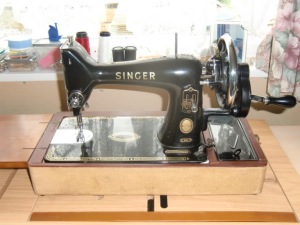 Singer 222K – (Vera or Suzy if she is especially sweet)
Singer 222K – (Vera or Suzy if she is especially sweet)
This machine I bought in April 2014. It is a 1960 Singer Featherweight 222K Convertible. I had been looking for one for over 12 months as it is the ideal size to take away in our motorhome and means that I will still be able to work on my hobby while we are away.
I had received an email from a forum member on TreadleOn talking about her machines, which included a 221k and it set my mind to thinking I needed to look on Ebay again – and there it was, with about 10 hours to go til the end time. I spent several hours searching the web and Ebay regarding prices, conditions and what was a reasonable price to pay for what was on offer. I set my price and waited until 8 seconds before the end to bid – and of course I won!
The machine is a Red S badged machine, which means it was made during the last 18 months of the production at Kilbowie in Scotland. It came with 4 bobbins, has lots of original attachments, and has been fully serviced with a new belt and electric cord. Luckily I also found I already had a bobbin that fits that came with the New Home 360 – and I knew it wasn’t for that machine but didn’t know until now what machine it fitted.
She is named Vera after the grandmother whose machine it was, and Suzy for the granddaughter I bought it off.
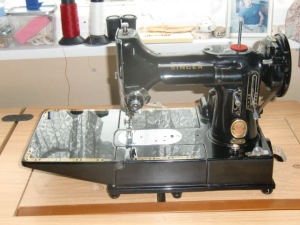 Many people don’t realise how small this machine is, and when they see it think it is a toy or child’s machine. Here it is next to my 99k which itself is a 3/4 size machine.
Many people don’t realise how small this machine is, and when they see it think it is a toy or child’s machine. Here it is next to my 99k which itself is a 3/4 size machine.
Singer 12K – (Myfanwy)
I’m not sure why I wanted a Singer 12 Transverse Shuttle, but this is another machine I have been wanting for a while and one has now found its way home to me in June 2014. This machine is even older than my VS machines (28k and 27k) and comes before them in sewing machine development as it is a transverse shuttle (TS) machine. Mine is from 1883, and even though it’s badge says Singer MFC N.Y. it is not necessarily made in New York. I’m not sure how you tell, and because mine is actually in the UK it’s more than likely a 12k – but I don’t know for sure. Actually it may not even be a 12k, just a British made Singer 12. The Singer factory in 1882 was at Bridgeton Cross in Scotland, and gradually moved over the next 3 years to Kilbowie, Clydebank with the move being completed by 1885.
I spotted my machine on Ebay as a buy it now offer, and as usual did some research on normal prices, issues and problems before making my decision. The machine was being sold in aid of Tools for Self Reliance (T.F.S.R) which sends sewing machines to Africa, which I was really happy about. I loved Tanzania when I visited. The people are so friendly and resourceful and if there is one place I could emigrate to it would be Africa.
The machine was being offered unrestored, but without too much wrong with it, so as I considered it within my ability to get it working beautifully and the finish at least revived, if not restored, I decided to buy it. After a 60 mile journey, I met a lovely man and his partner for lunch, talked about the machine and then I came home with it!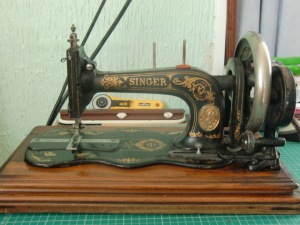 The machine came from the T.F.S.R. Warehouse in Wales, which holds machines people have donated that are not suitable to be sent to Africa, so that was one of the reasons I thought a Welsh name would be appropriate. It is also contemporary with my maternal grandparents who were both born in 1885. My grandfather’s favourite song was the Welsh love song Myfanwy (a man saying goodbye to his sweetheart who doesn’t want him any more – the last word of the song is ‘farewell’), and they used it for my mother’s middle name. It is pronounced Muv-van-oo-ee, with the emphasis on the second syllable – W and Y are vowels in Welsh. You can listen to it here
The machine came from the T.F.S.R. Warehouse in Wales, which holds machines people have donated that are not suitable to be sent to Africa, so that was one of the reasons I thought a Welsh name would be appropriate. It is also contemporary with my maternal grandparents who were both born in 1885. My grandfather’s favourite song was the Welsh love song Myfanwy (a man saying goodbye to his sweetheart who doesn’t want him any more – the last word of the song is ‘farewell’), and they used it for my mother’s middle name. It is pronounced Muv-van-oo-ee, with the emphasis on the second syllable – W and Y are vowels in Welsh. You can listen to it here
Vesta – (Rennie)
In order to restore my machines I have been watching Lizzie Lenard’s blog and on some of her videos she demonstrates on Vesta machines. These are German made and are of a wonderful quality to me – so when I saw this machine I just fell in love with the beautiful decals.
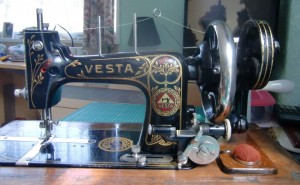 I bought it in July 2014 and it is a Vesta Transverse Shuttle from I believe the early 1930’s but they are very difficult to date accurately.
I bought it in July 2014 and it is a Vesta Transverse Shuttle from I believe the early 1930’s but they are very difficult to date accurately.
It looks little used as the decals are almost perfect, though the clear coat is crazing.
Initially I had trouble with the bottom tension and had difficulty getting it tight enough because the adjusting screw seemed stuck but luckily I have a small Singer bobbin tension screwdriver which did the trick.
I do not have any history of this machine, other than it came from Bournemouth, so I have called her Rennie, as the Art Nouveau decals are described as after Charles Rennie MacKingtosh. It seems the name can be either male or female.
Vesta – (Raphael – Rae)
One more Vesta I just had to have is what is called a Saxonia. These machines are typified by open cut helical gears, and a handle actually on the driving wheel.
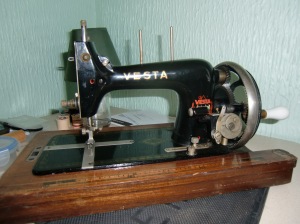 I wasn’t actually looking but came across this Little Vesta Saxonia from I believe the late 1930’s for just a few pennies so in September 2014 he found his way home to me!
I wasn’t actually looking but came across this Little Vesta Saxonia from I believe the late 1930’s for just a few pennies so in September 2014 he found his way home to me!
He’s definitely male to me – and has such classical lines, even though rather plain compared to my other Vesta.
This one had belonged to a woman called Anne Raphael Smith (know as ‘Rae’), so it just seem obvious to call him Raphael or Rae for short – I have no idea why she had a male middle name.
Anyway my pair of Vestas are now called Rennie and Rae – it just seems right somehow even though they aren’t German names.
Vesta – (Hedwig)
Well I seem to have acquired another Vesta! I was checking on ebay for a machine that wasn’t too pretty but with a good case and base to replace the one on Rennie above this Vesta Transverse Shuttle from the mid-1930’s . The case for her has a dent in it and the base is missing some veneer. I thought it would be easier to just replace the case and base than try to repair it and the cost would be about the same if I could find the right machine. And then I found it – in Nottingham – for £18. Luckily my step-daughter lives there so she was able to pick it up for me, and my husband brought it home after a work visit to Nottingham this month. So in November 2014 here she is!
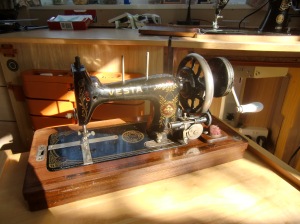 She is pretty dirty but is cleaning up nicely – once she is looking good and I have swapped the cases over I will move her on – either selling or giving her away.
She is pretty dirty but is cleaning up nicely – once she is looking good and I have swapped the cases over I will move her on – either selling or giving her away.
I don’t know if she sews yet though – but she did come with a shuttle and bobbin!
This machine also has no history – but since I have owned it, it has been a real battle to get some bits unstuck. I am still trying to release the stitch length regulator – so the German name of Hedwig seemed really appropriate. It means ‘battle/duel’!
Janome 15000 V2 – (No name yet)
Well – this really is my last machine (I believe!). It’s the very top of the range Janome Sewing/Quilting/Embroidery machine – a 2014 Janome Horizon 15000 Version 2. This should last me until I cross the Rainbow Bridge (to meet my dear Springer Spaniel Sam!).
It just does everything – but it still doesn’t have as good a straight stitch as my 1895 Singer 28k!
I finally decided a couple of months ago that I would buy a new machine that would do ‘everything’ given the limited space I have for separate machines – and also given that I had issues with my Elna (which are now happily resolved thank goodness). So here it is in October 2014.
I had toyed with embroidery when I bought the Elna but decided against it but now I am going to give it a go. I’ve already done some test embroideries and I am very impressed – so there will be more to come.
The machine is huge – even bigger than the Singer 27k – and comes with 21 different feet, and loads of other accessories.
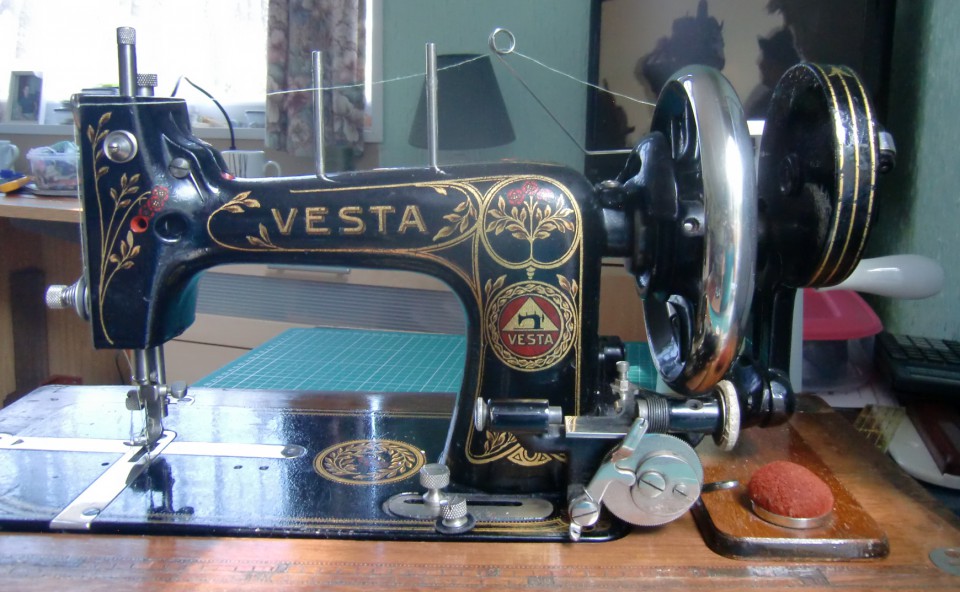
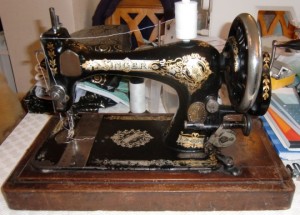
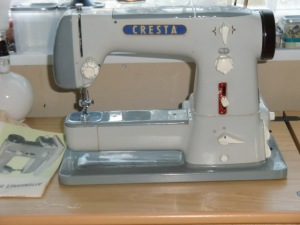
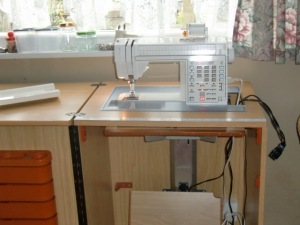
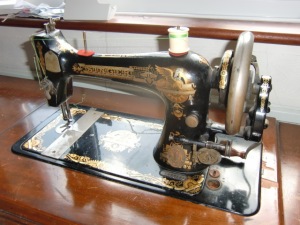
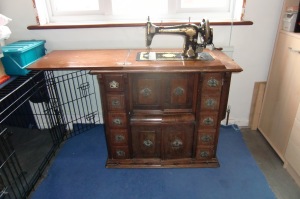
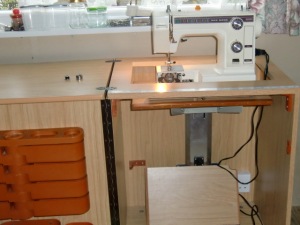
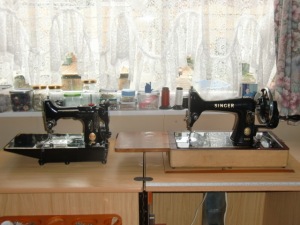
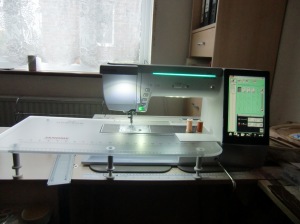
What a lovely collection of machines you have. Love your blog Anne, writting you an email, cheers Muffy who is known as Mafanwy.
LikeLike
Your 27 with the cabinet is beautiful; what a lovely birthday gift! A good thing for the machine too, a whole new lease of life 🙂
LikeLike
That drawing room cabinet for your 27 is lovely! I’ve only come across a few of those cabinets. Maybe one of these days I’ll own one, too.
LikeLike
Thank you Cheryl. The picture makes it look in better condition than it is! Lots to do on it yet. I have seen quite a few on ebay here in UK – including one perfectly restored with a 28k in it – one of the ones you could move between the cabinet and a table to use as a handcrank.
LikeLike